2021 MERCEDES-BENZ GLE COUPE ESP
[x] Cancel search: ESPPage 41 of 466
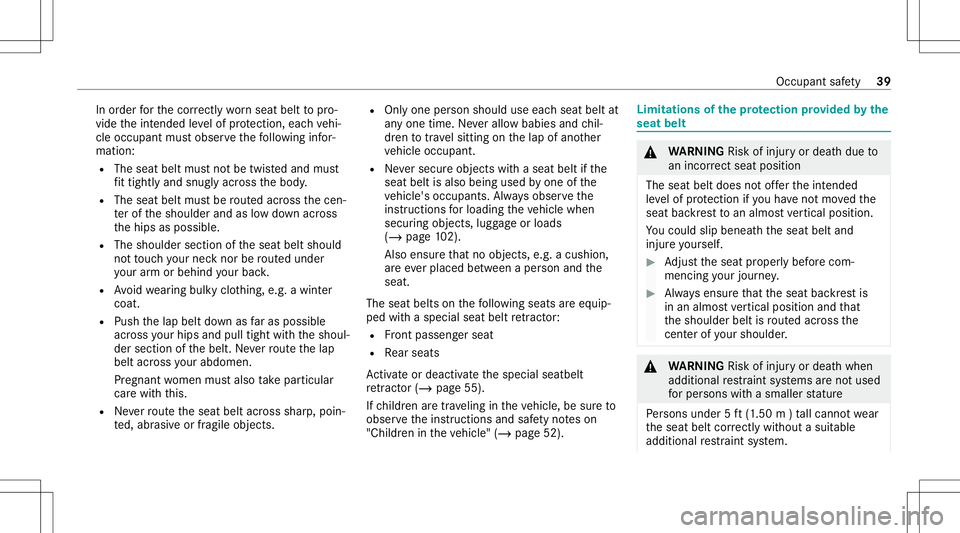
In
order forth ecor rectly wornseat belttopro‐
vide theint ended leve lof protect ion, eachve hi‐
cle occupant mustobser vethefo llo wing infor‐
matio n:
R The seat beltmustno tbe twis tedand must
fi t tig htly and snuglyacr oss thebody .
R The seat beltmustbe routed acr oss thecen‐
te rof theshoulder andaslow do wn across
th ehips aspossible.
R The shoulder sectionoftheseat beltshould
no tto uc hyo ur neck nor berouted und er
yo ur arm or behin dyo ur bac k.
R Avoid wearing bulk yclo thing, e.g. awint er
coat .
R Push thelap belt down asfaras possi ble
acr oss your hips andpulltight wit hth eshoul‐
der sect ionofthebelt. Neverro uteth elap
belt across your abdom en.
Pr egn ant women mustals ota ke par ticular
car ewit hth is.
R Neverro uteth eseat beltacross shar p,poin‐
te d, abr asiv eor fragile objec ts. R
Onlyone person should useeachseat beltat
an yone time. Neverall ow babies andchil‐
dr en totrave lsitt ing onthelap ofano ther
ve hicle occupant.
R Neversecur eobjects withaseat beltifth e
seat beltisalso being usedbyone ofthe
ve hicle's occupants. Alwaysobser vethe
ins truct ions forloa ding theve hicle when
secur ingobject s,lugg ageor loads
(/ page10 2).
Als oensu rethat no obj ect s,e.g .a cus hion ,
ar eev er placed between aper son and the
seat.
The seat belts onthefo llo wing seats areeq uip‐
ped withaspec ialseat beltretract or:
R Front passeng erseat
R Rear seat s
Ac tivateor deacti vate thespecial seatbelt
re tract or(/ page 55).
If ch ildr enaretrav eling intheve hicle, besur eto
obser vetheins truction sand safetyno teson
"Chi ldren intheve hicle" (/page52). Limitations
ofthepr otection prov ided bythe
seat belt &
WARNIN GRisk ofinju ryor deat hdue to
an incorrect sea tpos ition
The seatbel tdoe sno tof ferth eint ended
le ve lof protect ion ifyo uha ve notmo vedth e
seat backres tto an almos tve rtical posit ion.
Yo uco uld slip beneathth eseat beltand
injur eyo urself . #
Adjus tth eseat proper lybef orecom‐
menc ingyour jour ne y. #
Alw aysensur eth at theseat backres tis
in an almos tve rtical posit ionand that
th eshoulder beltisrouted acr oss the
cent erofyour sho ulder . &
WARNIN GRisk ofinju ryor deat hwhen
additional restra int systems areno tused
fo rper sons withasmal lerstatur e
Pe rsons under 5ft (1.50 m)ta llcan notwe ar
th eseat beltcorrectly without asuit able
additional restra int system. Occ
upant safety 39
Page 46 of 466

ot
her wise beinthedeplo yment area ofthe
airbag s.
R Alw ayske ep your feet on thefloor .Do not
put your feet on thecoc kpit, forex am ple.
Yo ur feet ma yot her wise beinthedeplo y‐
ment area oftheairbag.
R Ifch ildr enaretrave ling intheve hicle,
obser vetheadditional notes(/ page52).
R Alw aysst ow and secureobj ect scor rectl y.
Objects intheve hicle interior maypr ev ent an
airbag from func tioningcorrectl y.Eac hve hicle
occupant mustalw aysmak esur eof thefo llo w‐
ing inpar ticular :
R Ther ear eno people, animals orobje cts
be tween theve hicle occupants andanair‐
bag.
R Ther ear eno object sbe tween theseat, door
and door pillar (B-pillar).
R Ther ear eno har dobjec ts,e.g. coat hangers,
hanging onthegr ab handles orcoat hooks.
R Ther ear eno accessor ypar ts,suc has mobile
na vig ation devices, mobile phones orcup
holder s,att ached totheve hicle within the deplo
yment area ofan airbag, e.g.onthe
coc kpit, onthedoor ,on theside windo wor
on theside walltrim.
In addition ,no con nectingcables, tensi oni ng
st ra ps orretainin gst ra ps mus tbe routed or
att ached totheve hicle within thedeplo y‐
ment area ofan airbag. Alwayscom plywith
th eaccessor ymanuf acturer'sinstallation
ins truct ions and, inpar ticular ,th eno teson
suit able places forins tallation .
R Ther ear eno hea vy,shar p-edg edorfra gile
obje ctsin thepoc kets of your clo thing. Store
suc hobject sin asuit able place. Limit
edprotection prov ided byairbags &
WARNIN GRisk ofinju rydue tomodif i‐
cations totheco verof an airb ag
If yo umod ifytheco verof an airb agoraffix
object ssuc has sticke rs to it,theairbag may
no long erfunc tion correctly . #
Nevermodify theco verof an airb agand
do notaf fix obje ctstoit. The
installation locationofan airbag isident ified
by theairbag symbol (/page42). &
WARNIN GRisk ofinju ryor deat hdue to
th euse ofunsuit ableseat covers
Due touns uitable seat covers,th eairbags
cann otprotect vehicle occupants asinten‐
ded.
In addition, theoper ation oftheaut omatic
fr ont passeng erairbag shutoffcould be
re strict ed. #
Yousho uld onlyuse seat covers that
ha ve been approved forth ecor respond‐
ing seats byMer cedes-Ben z. &
WARNIN GRisk ofinju rydue tomalfu nc‐
tioning sensorsin thedoor
The func tion oftheairbags canbeimpair ed
due tomodif icationsorincor rect wo rkper‐
fo rm ed on thedoor sor door trim, orifth e
door sar edamag ed. #
Nevermodify thedoor sor par tsof the
door s. 44
Occupant safety
Page 48 of 466
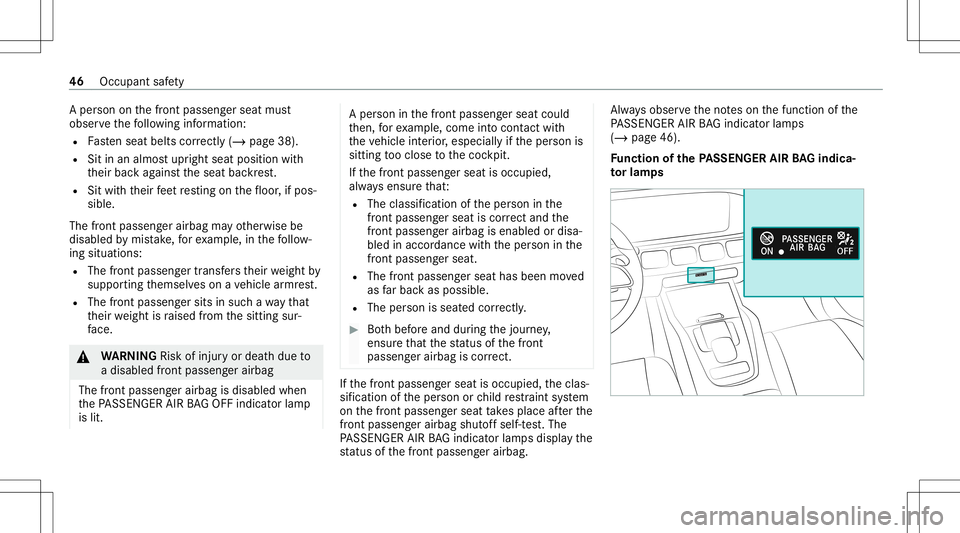
A
pe rson onthefront passeng erseat must
obser vethefo llo wing informatio n:
R Fasten seat belts correctl y(/ page 38).
R Sitinan almos tupr ight seatposi tion with
th eir bac kag ains tth eseat backres t.
R Sitwithth eir feet resting onthefloor ,if pos‐
sible.
The front passeng erairbag mayot her wise be
disabl edbymis take ,fo rex am ple, inthefo llo w‐
ing situat ions:
R The front passen gertr ansf ersth eir weight by
suppor tingthemselv eson ave hicle armr est.
R The front passeng ersits insuc hawa yth at
th eir weight israised from thesitt ing sur‐
fa ce. &
WARNIN GRisk ofinju ryor deat hdue to
a disable dfron tpasse nger airbag
The fron tpasse nger airbag isdisable dwhen
th ePA SSENGER AIRBAGOF Find icat orlam p
is lit. A
per son inthefront passeng erseat could
th en, forex am ple, com eint ocon tact with
th eve hicle interior ,especially ifth eper son is
sitt ing tooclose tothecoc kpit.
If th efront passeng erseat isoccupied,
alw aysensur eth at:
R The classificat ion oftheper son inthe
fr ont passeng ersea tis cor rect and the
fr ont passeng erairb agisenabl edordisa ‐
ble din accor dance withth eper son inthe
fr ont passeng ersea t.
R The front passeng ersea thas been moved
as farbac kas possi ble.
R The person isseat edcor rectl y. #
Both bef oreand during thejour ney,
ensur eth at thest atus ofthefront
passeng erairbag iscor rect. If
th efront passeng erseat isoccupied, theclas‐
sif ication oftheper son orchild restra int system
on thefront passeng erseat take splace afte rth e
fr ont passeng erairb agshut offself-t est.The
PA SSENGER AIRBAGind icat orlam psdispla yth e
st atus ofthefront passeng erairbag. Alw
aysobser vetheno teson thefunc tion ofthe
PA SSENGER AIRBAGind icat orlam ps
(/ page46).
Fu nction ofthePA SSEN GERAIRBAGindic a‐
to rlam ps 46
Occupant safety
Page 50 of 466
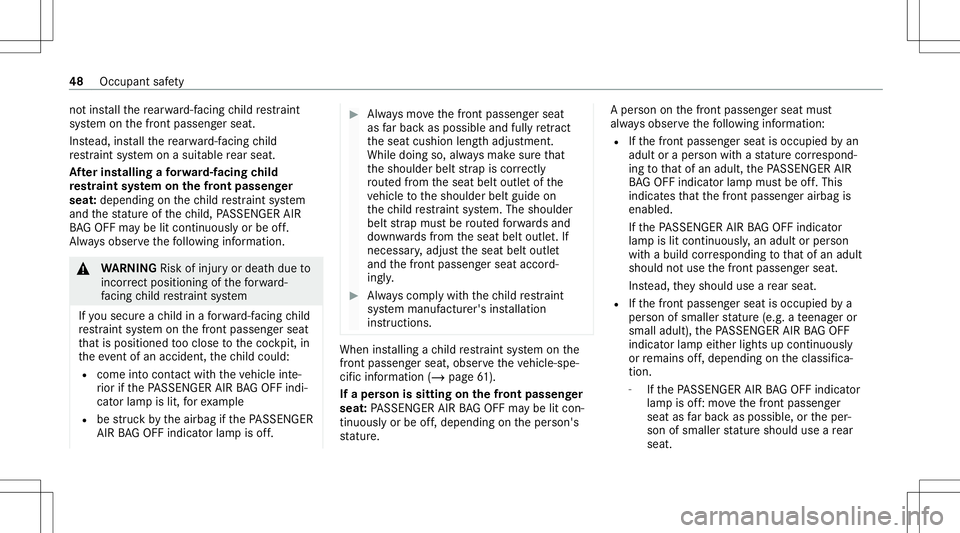
no
tins tallth ere ar wa rd-faci ng child restra int
sy stem onthefront passeng erseat.
Ins tead, installth ere ar wa rd-faci ng child
re stra int system onasuit able rear seat .
Af terin st alli ng afo rw ard-f acin gch ild
re stra int system onthefront passeng er
seat :depen dingonthech ild restra int system
and thest atur eof thech ild, PASSENGER AIR
BA GOF Fma ybe litcon tinuousl yor be off.
Alw aysobser vethefo llo wing informatio n. &
WARNIN GRisk ofinju ryor deat hdue to
inc orrect pos itioning ofthefo rw ard-
fa cing child restra int system
If yo usec ureach ild inafo rw ard-f acin gch ild
re stra int system onthefront passeng erseat
th at isposit ioned tooclose tothecoc kpit, in
th eev ent ofan acciden t,th ech ild could:
R com eint ocon tact with theve hicle inte‐
ri or ifth ePA SSENGER AIRBAGOF Find i‐
cat orlam pis lit,fo rex am ple
R bestru ck bytheairbag ifth ePA SSENGER
AIR BAGOF Find icat orlam pis off. #
Alw aysmo vethefront passeng erseat
as farbac kas possi bleand fully retract
th eseat cushion lengthadjus tment.
While doing so,alwaysmak esur eth at
th eshoulder beltstra pis cor rectl y
ro uted from theseat beltoutle tof the
ve hicle totheshoulder beltguide on
th ech ild restra int system. Theshoulder
belt stra pmus tbe routed forw ards and
do wn wardsfrom theseat beltoutle t.If
neces sary,adjus tth eseat beltoutle t
and thefront passeng erseat accor d‐
ing ly. #
Alw ayscom plywit hth ech ild restra int
sy stem manuf acturer'sinstallation
ins truct ions . When
installing ach ild restra int system onthe
fr ont passeng ersea t,obse rveth eve hicle-spe‐
cif icinf ormation (/page61 ).
If aper son issit tin gon thefront passeng er
seat :PA SSENGER AIRBAGOF Fma ybe litcon ‐
tin uousl yor be off,depen dingon theper son's
st atur e. A
per son onthefront passeng erseat must
alw aysobser vethefo llo wing informatio n:
R Ifth efront passeng erseat isoccupied byan
adult oraper son withast atur ecor respond‐
ing tothat ofan adult ,th ePA SSENGER AIR
BA GOF Find icat orlam pmus tbe off.This
ind icat esthat thefront passeng erairbag is
enabled.
If th ePA SSENGER AIRBAGOF Find icat or
lam pis lit con tinuousl y,an adult orper son
wit habuild corresponding tothat ofan adult
shoul dno tuse thefront passeng erseat.
Ins tead, they should useare ar seat .
R Ifth efront passeng erseat isoccupied bya
per son ofsmaller statur e(e. g.ate enag eror
small adult), thePA SSENGER AIRBAGOF F
ind icat orlam peit her light sup con tinuousl y
or remains off,depe nding ontheclassif ica‐
tion .
- Ifth ePA SSENGER AIRBAGOF Find icat or
lam pis off:mo vethefront passeng er
seat asfarbac kas possi ble,ortheper‐
son ofsmaller statur eshoul duse are ar
seat . 48
Occupan tsaf ety
Page 55 of 466
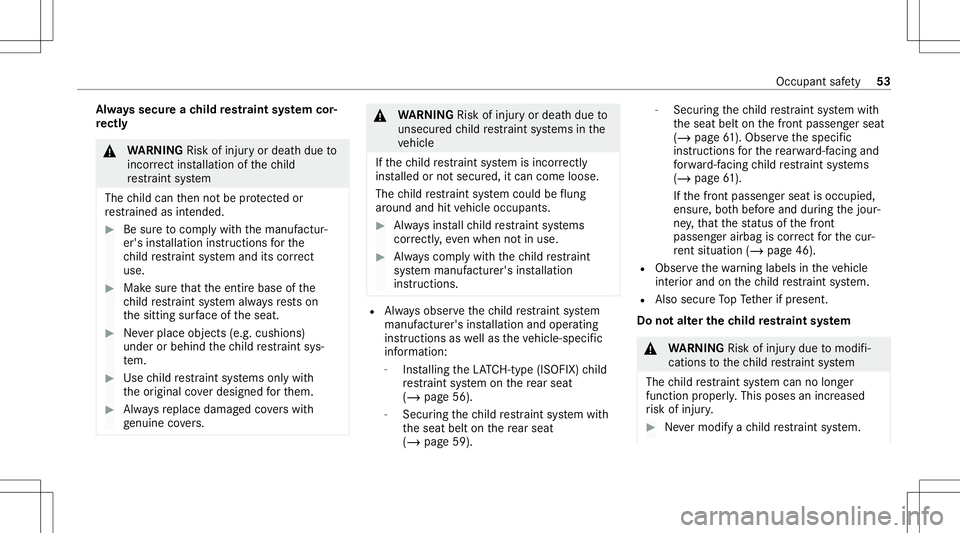
Alw
ayssecur each ild restra int system cor‐
re ctl y &
WARNIN GRisk ofinju ryor deat hdue to
inc orrect ins tallation ofthech ild
re stra int system
The child can then notbe protect edor
re stra ined asintended . #
Besureto com plywith themanuf actur‐
er's installation instruct ions forth e
ch ild restra int system and itscor rect
us e. #
Makesur eth at theent ire base ofthe
ch ild restra int system alwaysre stson
th esitt ing surface oftheseat. #
Neverpla ceobjects (e.g.cushi ons)
under orbehi ndthech ild restra int sys‐
te m. #
Use child restra int systems onlywit h
th eor iginal coverdesi gned forth em. #
Alw aysre place damag edcovers wit h
ge nui ne covers. &
WARNIN GRisk ofinju ryor deat hdue to
uns ecur edchild restra int systems inthe
ve hicle
If th ech ild restra int system isincor rectl y
ins talled ornotsecur ed,itcan com eloose.
The child restra int system could beflung
ar oun dand hitvehicle occupants. #
Alw aysins tallch ild restra int systems
cor rectl y,eve nwh en notin use. #
Alw ayscom plywit hth ech ild restra int
sy stem manuf acturer'sinstallation
ins truct ions . R
Alw aysobser vethech ild restra int system
manuf acturer'sinstallation andopera ting
ins truct ions aswellas theve hicle-specif ic
inf ormation:
- Installing theLA TC H-type (ISOFIX )ch ild
re stra int system onthere ar seat
(/ page56).
- Sec uring thech ild restra int system with
th eseat beltonthere ar seat
(/ page59). -
Sec uring thech ild restra int system with
th eseat beltonthefront passeng erseat
(/ page61 ).Ob serveth especif ic
ins truction sfo rth ere ar wa rd-faci ng and
fo rw ard-f acin gch ild restra int systems
(/ page61 ).
If th efront passeng erseat isoccupied,
ensur e,bo th bef oreand during thejour‐
ne y,that thest atus ofthefront
passeng erairbag iscor rect forth ecur‐
re nt situa tion(/ page 46).
R Obse rveth ewa rning labels intheve hicle
int erior and onthech ild restra int system.
R Also secur eTo pTe ther ifpr esent .
Do notalt er thech ild restra int system &
WARNIN GRisk ofinju rydue tomodif i‐
cations tothech ild restra int system
The child restra int system can nolong er
func tion proper ly.Thi spos esan incr eased
ri sk ofinjur y. #
Nevermodify ach ild restra int system. Occ
upant safety 53
Page 58 of 466
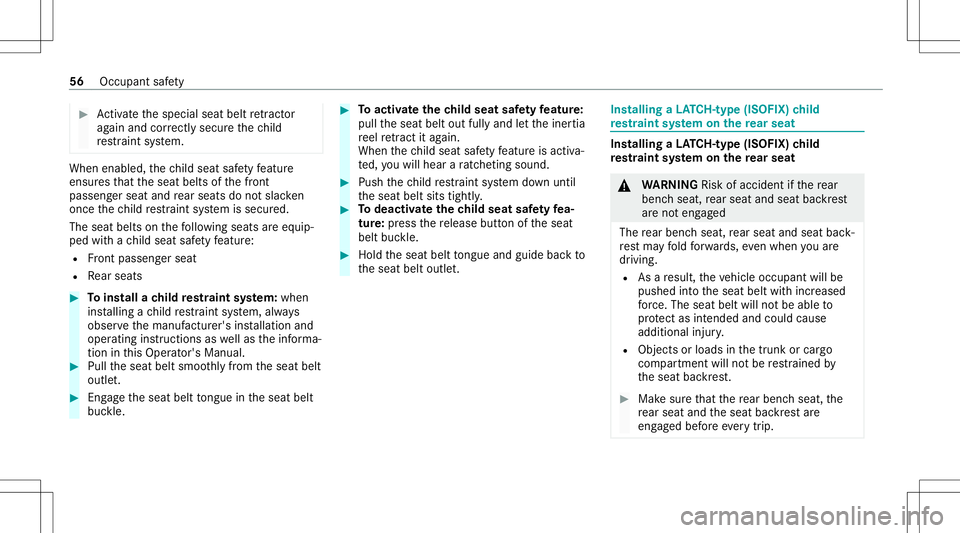
#
Activateth especial seatbeltretract or
ag ain and correctl ysecu rethech ild
re stra int system. When
enabled, thech ild seat safetyfe atur e
ens ures that theseat belts ofthefront
passeng erseat andrear seat sdo notslac ken
once thech ild restra int system issecur ed.
The seat belts onthefo llo wing seats areeq uip‐
ped withach ild seat safetyfe atur e:
R Front passeng erseat
R Rear seat s #
Toins tall ach ild restra int system: when
ins talling ach ild restra int system, always
obser vethemanuf acturer'sinstallation and
opera tingins truct ions aswellas theinf orma‐
tion inthis Oper ator's Manual. #
Pull theseat beltsmoo thly from theseat belt
outle t. #
Engage theseat belttongu ein theseat belt
buc kle. #
Toactiv ateth ech ild seat safetyfe atur e:
pul lth eseat beltoutfully andletth einer tia
re el retract itag ain.
Wh enthech ild seat safetyfe atur eis act iva‐
te d, youwill hear ara tche ting sound. #
Push thech ild restra int system down until
th eseat beltsitstight ly. #
Todeac tivatethe child seat safetyfe a‐
tur e:press there lease buttonoftheseat
belt buckle. #
Hold theseat belttongu eand guide ba ck to
th eseat beltoutle t. Ins
talling aLA TC H-type (ISOFI X)child
re stra int system onthere ar seat Ins
tallingaLA TC H-type (ISOFI X)child
re stra int system onthere ar seat &
WARNIN GRisk ofacci dent ifth ere ar
ben chseat, rear seat andseat backres t
ar eno teng aged
The rear ben chseat, rear seat andseat back‐
re st ma yfo ld forw ards, evenwh en youar e
dr ivin g.
R Asare sult, theve hicle occupant willbe
pushed intoth eseat beltwithincr eased
fo rc e. The seat beltwillnotbe able to
pr otect asintended andcould cause
additional injury.
R Objects orloads inthetrunk orcar go
com partmen twill notbe restra ined by
th eseat backres t. #
Mak esur eth at there ar ben chseat, the
re ar seat andtheseat backres tar e
eng aged bef oreeve rytrip . 56
Occupant safety
Page 62 of 466
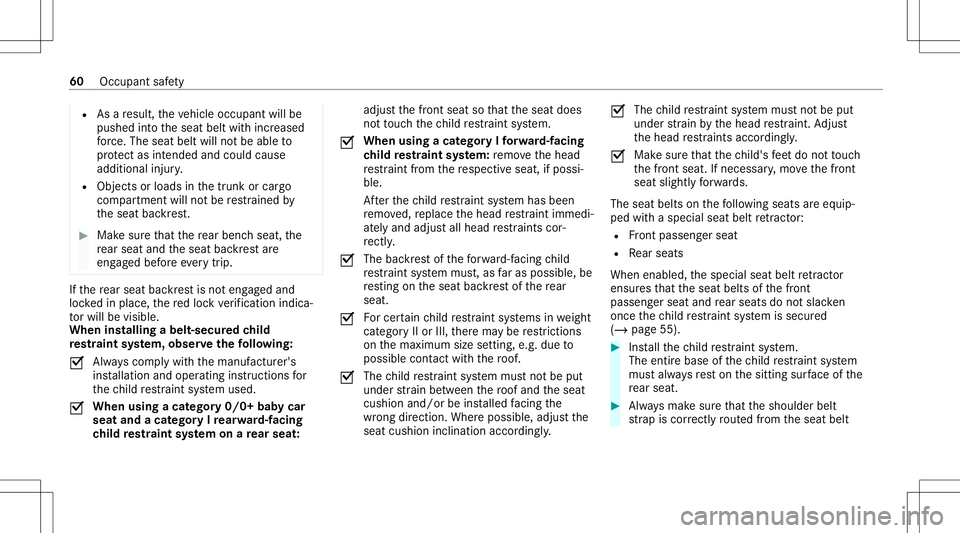
R
Asare sult, theve hicle occupant willbe
pushed intoth eseat beltwithincr eased
fo rc e. The seat beltwillnotbe able to
pr otect asintended andcould cause
additional injury.
R Objects orloads inthetrunk orcar go
com partmen twill notbe restra ined by
th eseat backres t. #
Mak esur eth at there ar ben chseat, the
re ar seat andtheseat backres tar e
eng aged bef oreeve rytrip . If
th ere ar seat backres tis no teng aged and
loc kedin place, there dloc kve rificati onindi ca‐
to rwil lbe visib le.
When install ing abel t-secur edchild
re stra int system, obser vethefo llo wing:
0073 Alw
ayscom plywit hth emanuf acturer's
ins tallation andoper atingins truct ions for
th ech ild restra int system used.
0073 When
usingacat egor y0/0+ babycar
seat andacat egor yIre ar wa rd-faci ng
ch ild restra int system onare ar seat : adju
stthefront seat sothat theseat does
no tto uc hth ech ild restra int system.
0073 When
usingacat egor yIfo rw ard-f acin g
ch ild restra int system: remo vethehead
re stra int from there spectiv eseat, ifpossi‐
ble.
Af terth ech ild restra int system has been
re mo ved, replace thehead restra int immed i‐
at elyand adjus tall head restra int scor ‐
re ctly .
0073 The
backrest of thefo rw ard-f acin gch ild
re stra int system mus t,as faras possi ble,be
re sting ontheseat backres tof there ar
seat .
0073 Fo
rcer tain child restra int systems inwe ight
cat egor yII or III,th er ema ybe restrictions
on themaximum sizesetting, e.g. due to
possible contact with thero of.
0073 The
child restra int system mus tno tbe put
under stra in be tween thero of and theseat
cushion and/orbeinstalled facing the
wr ong direct ion. Wher eposs ible, adjus tth e
seat cushion inclination accordingly. 0073
The
child restra int system mus tno tbe put
under stra in by thehead restra int .Ad jus t
th ehead restra int sacc ording ly.
0073 Mak
esur eth at thech ild's feet do notto uc h
th efront seat. Ifneces sary,mo vethefront
seat slightl yfo rw ards.
The seat beltson thefo llo wing seats areeq uip‐
ped withaspec ialseat beltretract or:
R Front passeng erseat
R Rear seat s
When enabled,thespecial seatbeltretract or
ens ures that theseat belts ofthefront
passeng erseat andrear seat sdo notslac ken
once thech ild restra int system issecur ed
(/ page55). #
Installth ech ild restra int system.
The entire base ofthech ild restra int system
mus talw aysre st on thesitt ing surface ofthe
re ar seat . #
Alw aysmak esur eth at theshoulder belt
st ra pis cor rectly routed from theseat belt 60
Occupant safety
Page 63 of 466
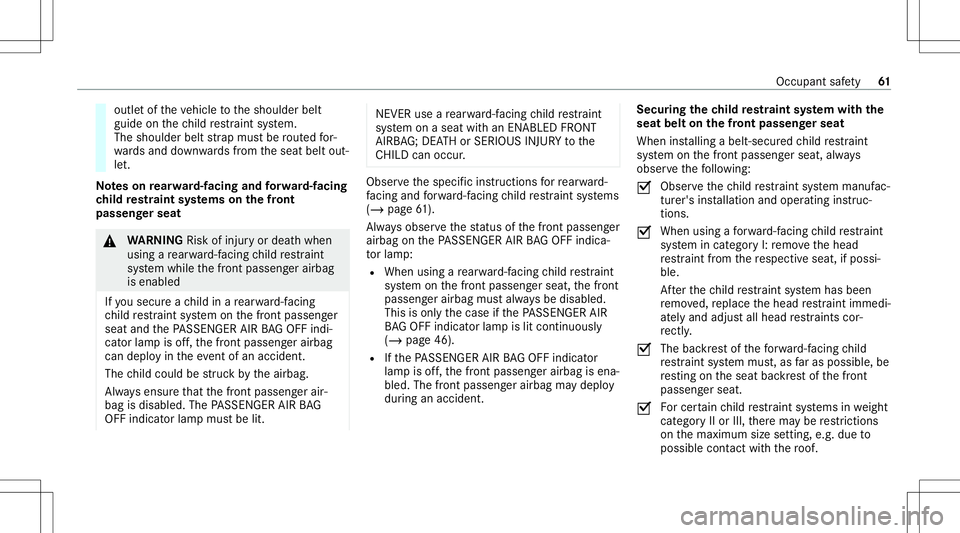
outle
tof theve hicle totheshoulder belt
guide onthech ild restra int system.
The shoulder beltstra pmus tbe routed for‐
wa rdsand down wardsfrom theseat beltout‐
le t.
No teson rear wa rd-faci ng and forw ard-f acin g
ch ild restra int systems onthefront
pa sseng erseat &
WARNIN GRisk ofinju ryor deat hwhen
using are ar wa rd-faci ng child restra int
sy stem while thefront passeng erairbag
is enabled
If yo usec ureach ild inare ar wa rd-faci ng
ch ild restra int system onthefront passeng er
seat andthePA SSENGER AIRBAGOF Find i‐
cat orlam pis off,th efront passeng erairbag
can deplo yin theev ent ofan acciden t.
The child could bestru ck bytheairbag.
Alw aysensur eth at thefront passeng erair‐
bag isdisabled. ThePASSENGER AIRBAG
OFF indicat orlam pmus tbe lit. NEVER
useare ar wa rd-faci ng child restra int
sy stem onaseat withan ENABL EDFRONT
AIRB AG;DE ATHor SERIOU SINJU RYtothe
CH ILD can occur . Obser
vethespecif icins truction sfo rre ar wa rd-
fa cing andforw ard-f acin gch ild restra int systems
(/ page61 ).
Alw aysobser vethest atus ofthefront passeng er
airbag onthePA SSENGER AIRBAGOF Find ica‐
to rlam p:
R When using are ar wa rd-faci ng child restra int
sy stem onthefront passeng erseat, thefront
passeng erairbag mustalw aysbe disabl ed.
This isonl yth ecase ifth ePA SSENGER AIR
BA GOF Find icat orlam pis lit con tinuousl y
(/ page46) .
R Ifth ePA SSENGER AIRBAGOF Find icat or
lam pis off,th efront passeng erairbag isena‐
bled. Thefront passeng erairbag maydeplo y
dur ing anacciden t. Secur
ingthech ild restra int system withth e
seat beltonthefront passeng erseat
When installing abelt- secur edchild restra int
sy stem onthefront passeng erseat, always
obser vethefo llo wing:
0073 Obser
vethech ild restra int system manuf ac‐
tur er's installation andoper atingins truc‐
tion s.
0073 When
usingafo rw ard-f acin gch ild restra int
sy stem incat egor yI: re mo vethehead
re stra int from there spectiv eseat, ifpossi‐
ble.
Af terth ech ild restra int system has been
re mo ved, replace thehead restra int immed i‐
at elyand adjus tall head restra int scor ‐
re ctly .
0073 The
backrest of thefo rw ard-f acin gch ild
re stra int system mus t,as faras possi ble,be
re sting ontheseat backres tof thefront
passeng erseat.
0073 Fo
rcer tain child restra int systems inwe ight
cat egor yII or III,th er ema ybe restrictions
on themaximum sizesetting, e.g. due to
possible contact with thero of. Occupant
safety 61